The river . . . is the living symbol of all the life it sustains or nourishes—fish, aquatic insects, water ouzels, otter, fisher, deer, elk, bear, and all other animals, including man, who are dependent on it or who enjoy if for its sight, its sound, or its life. —Justice William O. Douglas (1898-1980)
🌿 🌿 🌿
Some days just beckon for a day on the trail, and this particular day was one of them. It wasn’t going to be a long hike (although I would have liked that) but no matter, any chance to be out on the trail is good enough for me, especially when it’s along a river. Our purpose for going was twofold—good weather and fishing.
Chris gathered his fishing gear, and I shouldered my backpack, and we were off. The weather had been unseasonably warm for late October. Autumn felt like summer. Even the trees were confused with mostly green leaves that had only traces of gold and bronze.
By the time we reached the river trail, I was sweating. The air, usually cooler along the river, was still 80 degrees. It was a fine day with a mix of warm air, the smell of the river, and the sight and sound of moving water. I wanted to soak up every bit of it.
From the river trail, we cut across a clearing, and then a shallow rivulet fed by an unnamed pond fed by an unnamed stream. The pool Chris would be fishing was a short hike upriver. I was heading downriver for no reason other than to simply poke around. I wished him luck, and left the trail to follow the riverbank.
The river was running a little high, and was unusually clear. River willows grew thick along the bank, and moving among them was like walking through a maze. Every branch grabbed at my pack, while twigs worked to poke an eye. I had to watch my footing, as there were obstacles everywhere. There were logs and branches, but mostly rocks that could easily swallow my boots whole and wrench an ankle. Other hurdles included a big rusted cable that curled like a serpent ready to strike, and I carefully stepped through its coils. Stopping wasn’t an option. There was little room, and the view poor. So I continued on.
Gazing through the willows I could see Chris and several other anglers fishing the deep pool where the river bends and the two rivers meet. The sky was incredibly blue, and there wasn’t a cloud in sight.

Emerging from the tangle of willows, I crossed a small sandbar that held the recent tracks of a lone raccoon. On the other side was a boulder garden; there are a lot of boulder gardens along this river, but most are unreachable when the river is up. I spied a nice boulder to sit, and although a little cramped, I reached it without getting my feet wet.

I sat with my back to the willows. Water circled the boulders, calm shallow pools where water striders skated. I embraced October’s warmth and all that was around me. So relaxed, I could have taken a nap, and I might have had it not been for the sweet melody that rose and fell above the roar of the river.
It was the song of the river minstrel, the American dipper (Cinclus mexicanus) a.k.a. water ouzel; the plump little gray bird with a cheerful voice and lively dance that never ventures far from moving water.




🌿The American dipper (Cinclus mexicanus) is a stout songbird 7 to 8 inches long from beak to tail having slate-gray feathers, short wings and tail, and a white eye-ring. Young birds have a yellowish beak and legs, while older birds have a dark beak and grayish-pink legs. The dipper makes its home along rushing streams, rivers, rapids and waterfalls, and will not tolerate pollution. To see a dipper in such a setting is to know that the water is clean. Because much of the dippers life is spent in and underwater, it must keep its feathers dry, which accounts for its oil gland, which is ten times larger than other songbirds. The dipper also has a watertight flap that seals the nostrils, and an extra eyelid or “nictitating membrane” that shields the eyes and allows the dipper to see underwater. Diet consists mainly of aquatic insects and larvae, but the dipper will also eat small fish, crawfish, tadpoles, aquatic eggs and plants. When it comes time to nest, the male helps the female build a dome-shaped nest using mosses and then lines the inside with grasses. The nest is built on rocky ledges, riverbanks, in tree roots, behind waterfalls, and even manmade structures so long as it is close to water. The female lays 4 to 5, white eggs, and will incubate them thirteen to seventeen days. After hatching, the male helps to feed and tend the young. At the end of summer, the American dipper molts its flight and tail feathers, which leaves it flightless and vulnerable for a short time.
____________________
Copyright 2014. All rights reserved.
Thank you for reading Nature Chronicles, and Happy 2014!



Another enjoyable foray into a most picturesque landscape – with beautiful photos – thanks!
Thank you so much, Thad. I really appreciate your comments and for reading my Nature Chronicles.